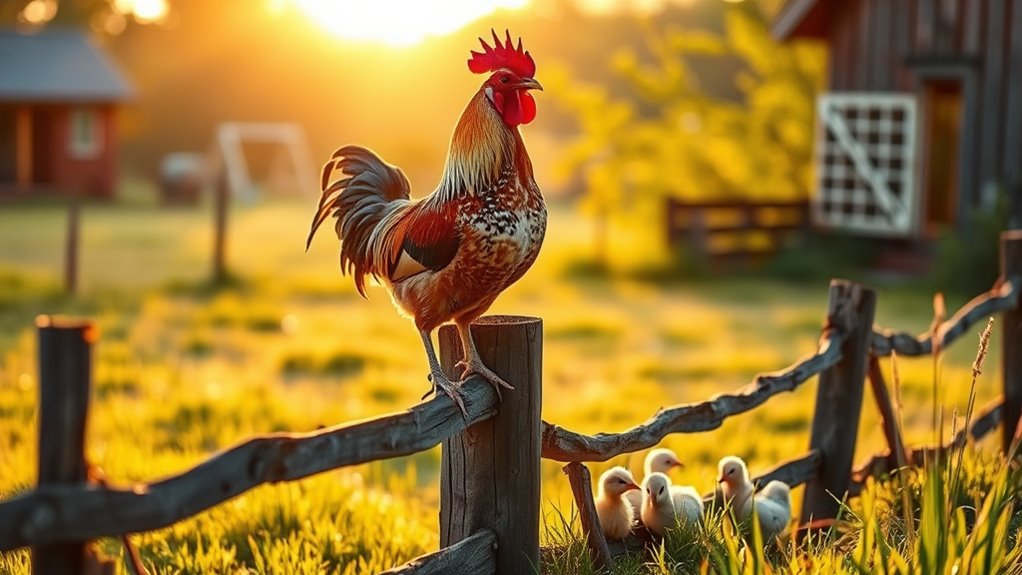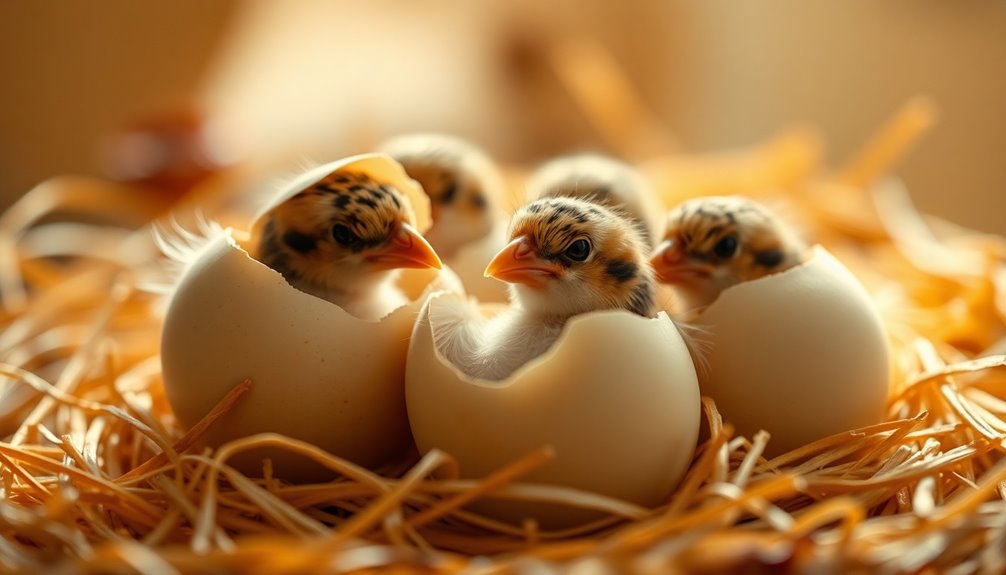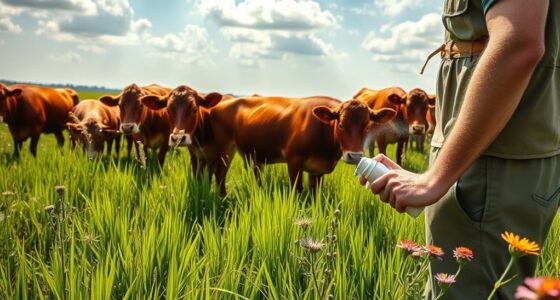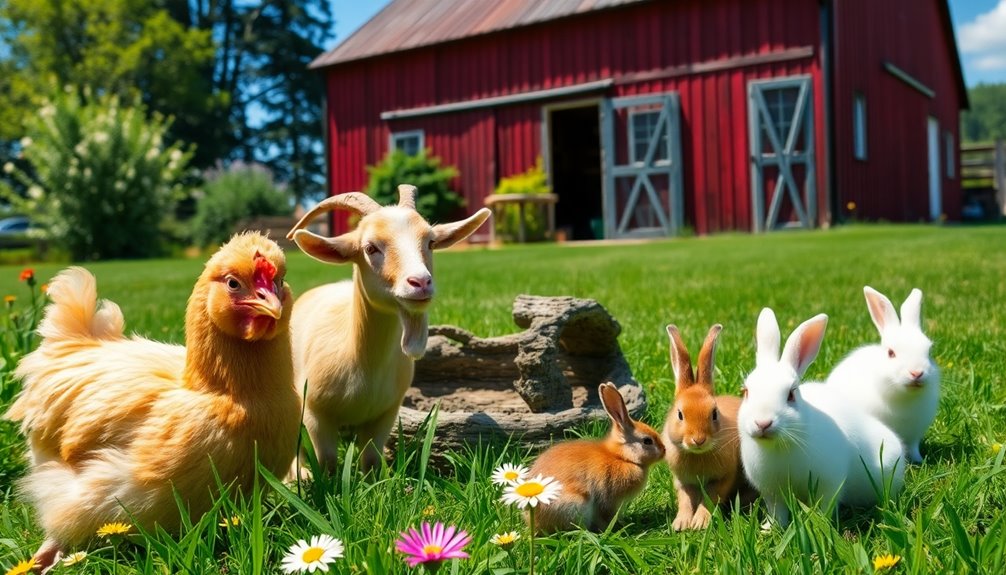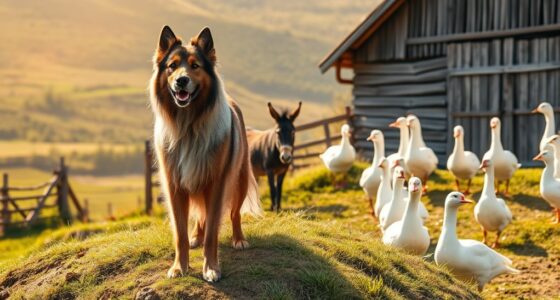Cockerels usually start crowing between 4 to 5 months old, but some can crow as early as 3 months or as late as 10 months, depending on their breed and environment. Smaller breeds, like bantams, tend to crow sooner than larger ones. Factors like social dynamics and seasonal changes also play a role in their vocal development. You'll discover more about how to encourage healthy crowing habits and manage excess vocalizations as you continue exploring!
Key Takeaways
- Cockerels typically start crowing between 4 to 6 months of age, with some beginning as early as 3 months.
- Smaller breeds, like bantams, often crow sooner than larger breeds, such as Rhode Island Reds.
- Initial crowing attempts may occur around 8 weeks but are usually squeaky and less pronounced.
- Environmental factors, like light and weather, can influence the frequency and timing of crowing.
- Social dynamics within the flock, including dominance behavior, also affect when cockerels begin to crow.
Age Range for Crowing
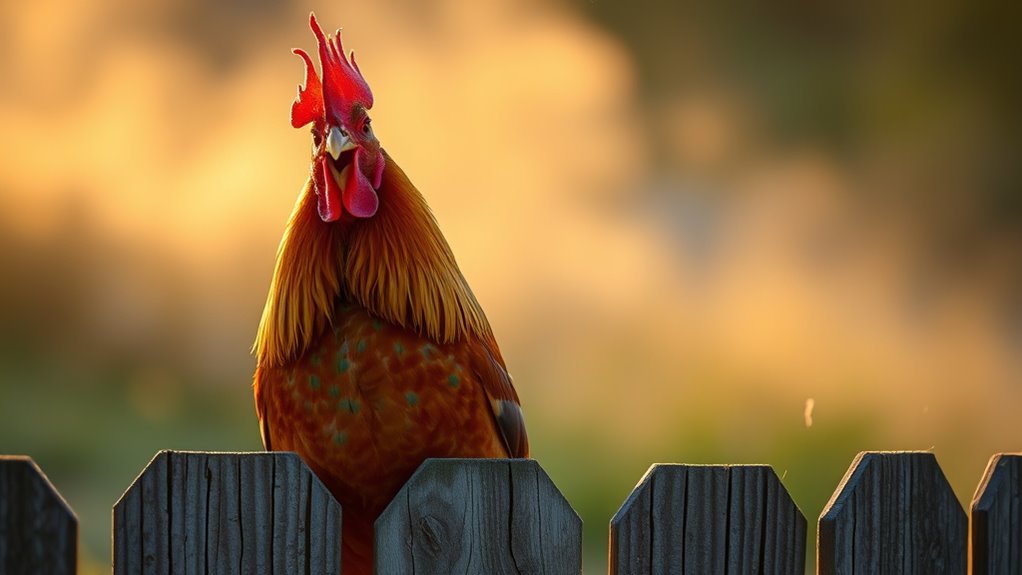
Most roosters begin crowing between 4 to 5 months old, marking a significant milestone in their development.
However, some cockerels might surprise you by starting as early as 3 months. On the flip side, late bloomers can hold off until around 6 to 10 months.
Cockerels can start crowing anywhere from 3 months to as late as 10 months, showcasing their unique growth patterns.
Breed can influence this timing—smaller breeds like bantams often crow sooner than larger ones such as Rhode Island Reds.
Alongside crowing, you'll notice them growing saddle feathers and developing their combs, which are signs of maturation.
Their initial vocalizations may sound like soft wheezes, evolving into a full crow over weeks.
Factors Influencing Crowing
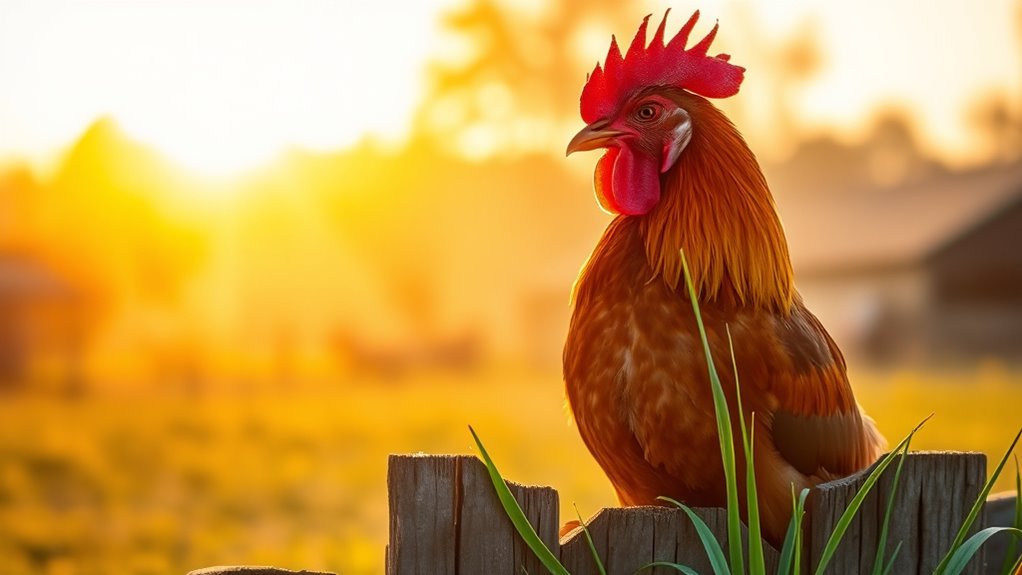
While several factors influence when and how often roosters crow, breed variations play a significant role in their vocal development. Different breeds mature at varying rates; for instance, bantams often crow earlier than larger breeds.
Breeds like Leghorns and Rhode Island Reds are known for their vocal tendencies, with noticeable differences in volume and pitch. Environmental factors also matter; urban settings can increase crowing due to stress and noise.
Changes in light, like supplemental lighting, can trigger crowing, while weather conditions may affect frequency. Social dynamics come into play too; dominant roosters often crow first, and their presence can stimulate others.
Lastly, stress and overall health significantly impact crowing behavior and vocal quality.
Developmental Milestones

As roosters grow, they reach specific developmental milestones that significantly influence their crowing behavior. Typically, they start crowing between four to six months, though some may attempt it as early as eight weeks with squeaky sounds.
By five months, you'll notice a full-bodied crow developing. Keep in mind that different breeds mature at varying rates; some may crow earlier while others take longer.
By five months, a rooster's crow becomes more pronounced, varying by breed as maturity rates differ.
Environmental conditions and stress can also impact when and how well they crow. As they mature, you'll see changes in their feather growth, comb development, and overall behavior, all of which contribute to their vocalization.
Monitoring these milestones helps ensure your rooster develops healthily and confidently.
Purpose of Crowing
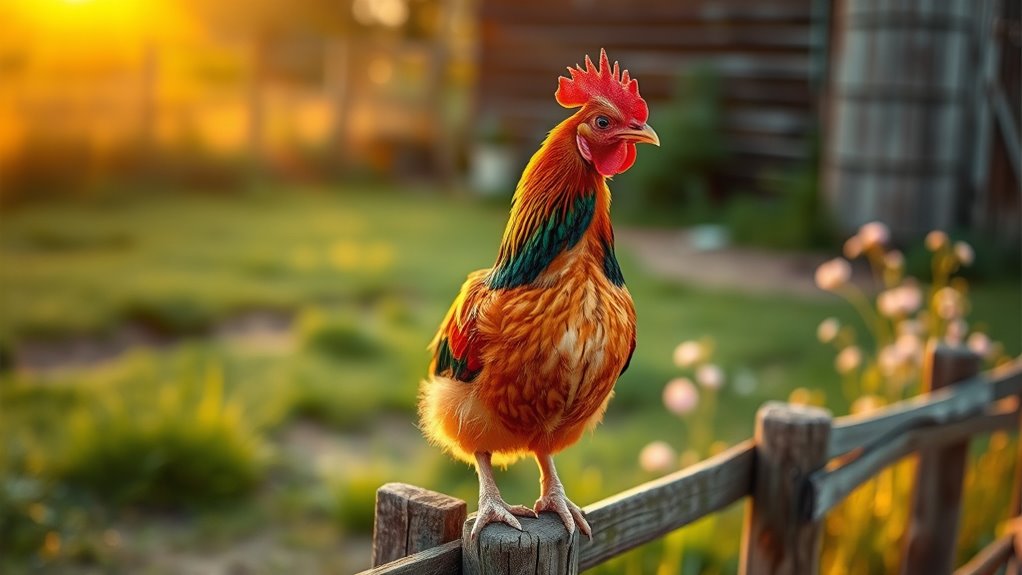
Crowing serves multiple essential purposes for roosters, primarily rooted in their instinctual behaviors.
First, it helps them claim territory, signaling to other roosters and potential threats that this space is theirs. It also establishes dominance within the flock, with the leading rooster often crowing first.
Additionally, roosters crow to announce feeding times, alerting hens to available resources. Communication is key, as crowing warns others of dangers and facilitates social interaction within the flock.
Moreover, it asserts their presence and pride. Ultimately, these vocalizations help maintain order, protect against predators, and attract hens, ensuring the rooster fulfills its role as a leader and protector within the flock.
Encouraging Healthy Development
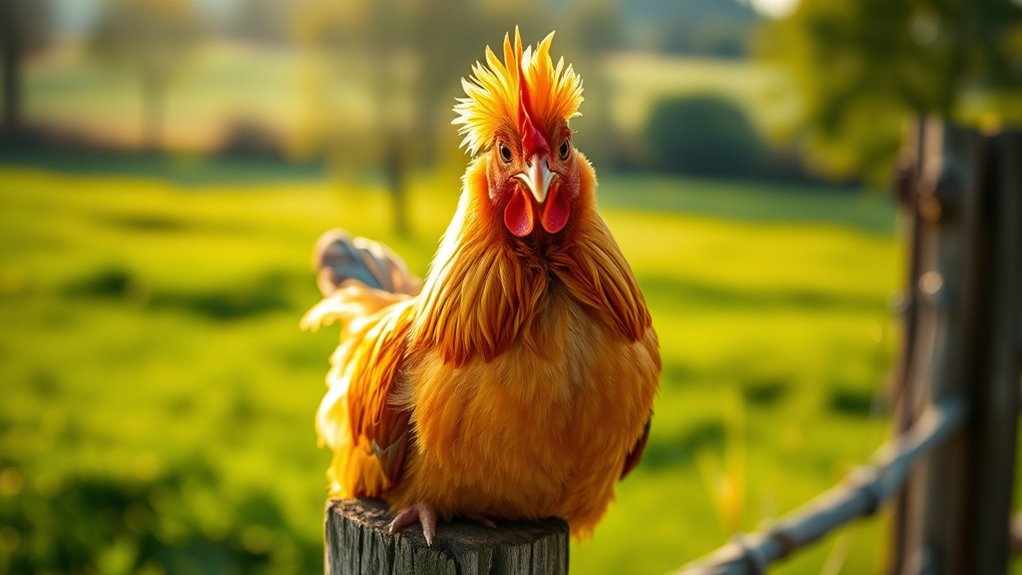
Encouraging healthy development in cockerels is vital for their growth and the eventual onset of crowing. Start by providing a balanced diet rich in protein and essential vitamins, ensuring they've access to clean water.
Space to roam is equally important; give them room to exercise and socialize, fostering natural behaviors. Monitor their environment, maintaining consistent lighting that mimics natural day-night cycles to support hormonal development.
Providing ample space for cockerels to roam encourages exercise and socialization, essential for fostering their natural behaviors.
Pay attention to stress levels, as high stress can delay crowing. Regularly observe your cockerels for signs of growth and behavior changes, keeping records to identify any issues early.
If you notice developmental delays, consult a veterinarian for tailored advice. Healthy cockerels will crow on schedule, showcasing their vibrant personalities.
Managing Excessive Crowing
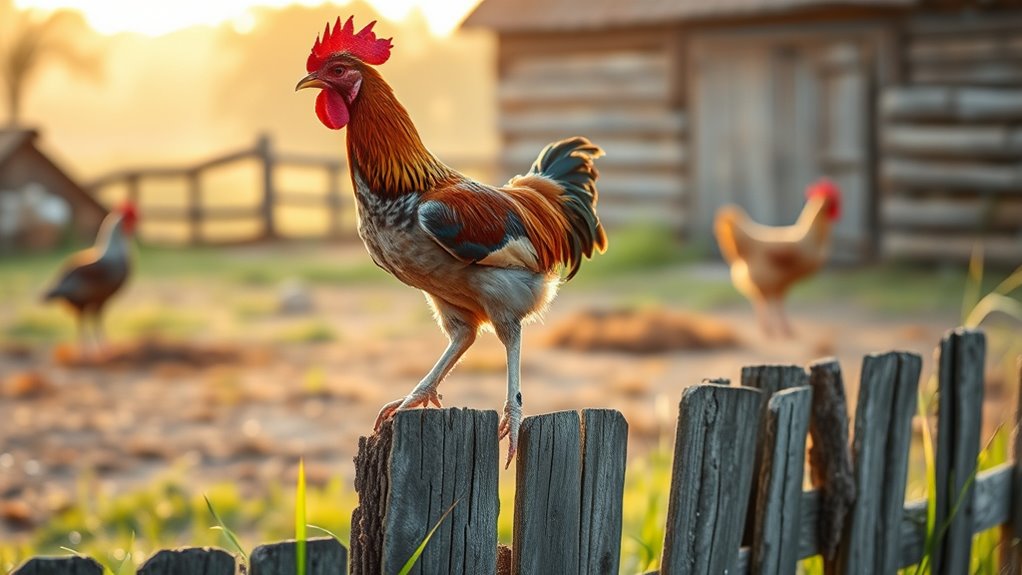
While managing excessive crowing can be challenging, there are effective strategies you can implement to create a more peaceful environment.
Start by darkening the coop during early mornings to alter your rooster's perception of time. Insulate the coop and add sound barriers to muffle crowing.
Introduce more hens for social interaction and provide distractions to minimize attention-seeking calls. Maintain regular feeding schedules and ensure your rooster has plenty of exercise opportunities.
Consider using a No Crow Collar to limit the volume and play calming background noise to mask sounds. Additionally, ensuring proper indoor air quality can help create a more comfortable environment for your rooster, which may reduce excessive crowing.
Finally, check local ordinances to stay compliant, and if necessary, explore rooster-friendly areas or alternative solutions to manage the noise effectively.
Frequently Asked Questions
Do All Cockerels Crow at the Same Age?
Not all cockerels crow at the same age. Factors like breed, environment, and individual development play significant roles in their crowing timeline.
Some might start as early as 8 weeks, while others could take several months. Social interactions with other roosters and proper nutrition can influence when they begin to vocalize.
Keep an eye on your cockerels; their unique traits will determine when they start to show off their crowing skills!
Can Hens Mimic Crowing Behavior?
Hens can mimic crowing behavior like a shadow mimics your movements. They might crow to assert dominance, especially in a mixed flock.
Hormonal changes or genetic traits can drive this behavior, making it more common in some hens than others. While their crowing is usually less frequent and softer than roosters', it can still disrupt the pecking order.
Managing crowing hens often involves observing their social dynamics and providing a stress-free environment.
How Can I Tell if My Cockerel Is Sick?
To tell if your cockerel is sick, watch for signs like lethargy, discoloration, or respiratory issues.
If he's eating less or losing weight, that's concerning.
Notice any behavioral changes, such as social withdrawal or unusual vocal sounds.
Check for physical symptoms like watery eyes or nasal discharge.
If you see these signs, isolate him, monitor his condition, and consult a veterinarian for proper care.
Keeping a clean environment can help prevent illness, too.
Will a Cockerel Crow More if Kept Alone?
Cockerels kept alone can crow considerably!
When isolated, they often increase their vocalization, seeking social stimulation and expressing stress.
The lack of feathered friends may trigger this behavior, turning your solitary cockerel into a chatty companion.
If you notice more crowing, it's likely due to his desire for interaction.
To help him feel more secure, consider fostering a friendly flock or providing engaging distractions to reduce his lonely lamentations.
Are There Silent Breeds of Roosters Available?
Yes, there are several quieter breeds of roosters you can consider.
Ameraucanas, Brahmas, and Buff Orpingtons are known for their calm dispositions and gentle natures. If you're looking for a rooster that won't disturb your neighbors, these breeds often fit the bill.
Barred Plymouth Rocks and Silkies are also quieter options.
Just remember to check local regulations about keeping roosters to ensure you're compliant with any noise restrictions.
Conclusion
In the journey of a cockerel, crowing marks the dawn of its maturity, like a sunrise heralding a new day. As you nurture your feathered friend, remember that patience and care shape its voice. Just as a garden flourishes with sunlight and water, your attention can encourage healthy crowing. Keep an eye on the rhythms of its song, managing any excessive calls like a gardener pruning for balance. In this way, you'll help your cockerel find its true voice.

